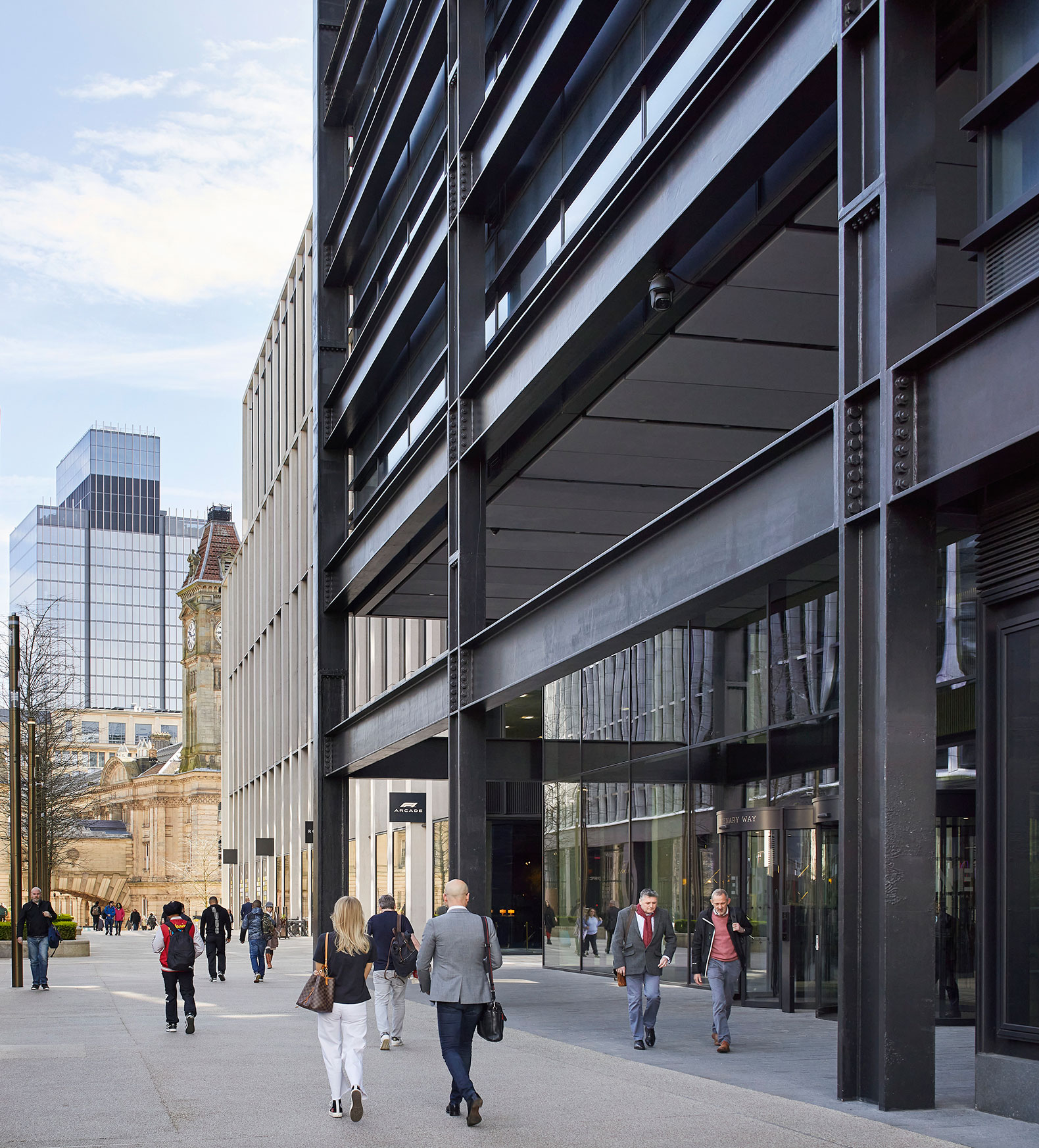
The building by Howells, characterized by its exoskeleton, is designed to represent Birmingham’s industrial heritage and acts as a giant bridge, with sixteen trusses transferring the load of the structure to either side of the tunnel and the exoskeleton providing stability to offset the high levels of movement of the tunnel below, a major thoroughfare in the city that remained fully operational throughout the construction process.
Inside, One Centenary Way employs a grid that is echoed by a rigorously composed façade with a strong horizontal emphasis, offering flexible floors to accommodate a multitude of organizations and favoring panoramic views of the city center. These spaces are also in keeping with the structurally expressive exterior through their exposed steel frames, accompanied by a palette of naturally textured materials.

New landmark in the city. "One Centenary Way" by Howells. Photograph by Hufton+Crow.
Project description by Howells
Howells completes One Centenary Way, a new landmark for Birmingham that defines the next generation of sustainable workspace, and another significant chapter in the city’s transformation into a lively, mixed-use metropolis.
The 13-storey building sits above the A38 Queensway Tunnel, negotiating a challenging, split-level site that connects two of the city’s most important civic spaces, Chamberlain Square and Centenary Square. It is the first completed building of phase two of Howells’ Paradise Masterplan and will provide workspace for 3,500 people, along with hospitality, outdoor terrace and communal amenities at ground floor level.
Constructed above a live piece of transport infrastructure, Howells collaborated closely with Arup to develop a structural design solution addressing the specific logistical challenges of the site. Characterised by its Vierendeel exoskeleton, the building is designed to express Birmingham’s industrial heritage and acts as a giant bridge, with sixteen one-storey trusses transferring the load of the structure to either side of the tunnel. The exoskeleton provides stability to compensate for a non-load bearing core and the high levels of movement from the tunnel below - a major city thoroughfare which remained fully operational throughout the construction process.
An 8 metre-high lantern on top of the building, constructed within the façade’s structural grid, features a changeable 360-degree light display visible from miles around, adding a colourful crown to Birmingham’s city skyline.

Internally, One Centenary Way’s layout employs a column-minimising 9x12m grid, mirrored by a rigorously composed façade with a strong horizontal emphasis. The interior offers flexible floorplates that cater to a multitude of organisations, from a creative engineering studio for Arup to a technology hub for Goldman Sachs, and offer panoramic views of the city centre. In keeping with the structurally expressive exterior, interior spaces feature exposed steel frames complemented by a material palette of natural textures and bespoke fittings.
The all-electric scheme features smart-enabled building management technology, which collects live data on energy and facility use, allowing for more efficient use of energy, water, and other amenities. With room for up to 500 bicycles, One Centenary Way also hosts Birmingham’s first large-scale cycle hub, providing secure lock-up space, alongside cyclists’ facilities including showers, locker rooms, servicing, and bike hire.
Maximising sustainability and reducing embodied carbon was central to the project, resulting in a structural design that minimises the use of concrete foundations and superstructure, instead utilising recycled steel manufactured in the UK by BHC Steel, using wind and biomass energy. Together, optimising the production route from factory to site and switching to rolled steel sections saved up to 6,000 tonnes of embodied CO2, reducing the building’s overall carbon footprint. The project is on track to achieve a BREEAM Excellent certification.

"We are immensely proud of our work at Paradise, and One Centenary Way is a significant chapter of that journey. A complex and challenging brief from the outset, this building represents the very best of collaborative working bringing together innovative engineering and design solutions to deliver a distinct new landmark for the city that defines the next generation of sustainable workspace."
Dav Bansal, Partner at Howells.
"The completion of One Centenary Way is another significant chapter in the story of Paradise and the city. It is a testament to the dedication and collaborative approach of the construction and design teams to deliver this complex new building with its exceptional SMART and sustainability credentials. The early success of the lettings only highlights that its exceptional quality has been recognised and endorsed by leading global businesses."
Rob Groves, regional development director at MEPC, the commercial property development and asset management arm of Federated Hermes.
“We are very proud of our new office, and our role in ensuring One Centenary Way is sustainable and innovative. Our new office showcases Arup’s commitment to delivering sustainable solutions and our net zero carbon aspirations One Centenary Way is an ideal new home where we can make our knowledge and global expertise easily accessible to clients and collaborators, while making meaningful contributions to the city and region.”
James Watts, Arup Birmingham Office Leader.
One Centenary Way forms part of the 186.000 sqm (two million sq. ft), 1400 million euros (£1.2 billion) "Paradise" Masterplan which includes the completion of an additional seven further buildings, including the 370-home, 155m-tall Octagon also designed by Howells, as well as further office, leisure and retail space and a 250-bedroom four-star hotel. On track for completion by 2030, the masterplan is set to transform the city centre into a more connected and liveable, European metropolis.

















































